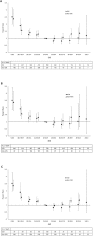Body Mass Index and Mortality in the General Population and in Subjects with Chronic Disease in Korea: A Nationwide Cohort Study (2002-2010)
- PMID: 26462235
- PMCID: PMC4604086
- DOI: 10.1371/journal.pone.0139924
Body Mass Index and Mortality in the General Population and in Subjects with Chronic Disease in Korea: A Nationwide Cohort Study (2002-2010)
Abstract
Background: The association between body mass index (BMI) and mortality is not conclusive, especially in East Asian populations. Furthermore, the association has been neither supported by recent data, nor assessed after controlling for weight changes.
Methods: We evaluated the relationship between BMI and all-cause or cause-specific mortality, using prospective cohort data by the National Health Insurance Service in Korea, which consisted of more than one million subjects. A total of 153,484 Korean adults over 30 years of age without pre-existing cardiovascular disease or cancer at baseline were followed-up until 2010 (mean follow-up period = 7.91 ± 0.59 years). Study subjects repeatedly measured body weight 3.99 times, on average.
Results: During follow-up, 3,937 total deaths occurred; 557 deaths from cardiovascular disease, and 1,224 from cancer. In multiple-adjusted analyses, U-shaped associations were found between BMI and mortality from any cause, cardiovascular disease, and cancer after adjustment for age, sex, smoking status, alcohol consumption, physical activity, socioeconomic status, and weight change. Subjects with a BMI < 23 kg/m2 and ≥ 30 kg/m2 had higher risks of all-cause and cause-specific mortality compared with the reference group (BMI 23-24.9 kg/m2). The lowest risk of all-cause mortality was observed in subjects with a BMI of 25-26.4 kg/m2 (adjusted hazard ratio [HR] 0.86; 95% CI 0.77 to 0.97). In subgroup analyses, including the elderly and those with chronic diseases (diabetes mellitus, hypertension, and chronic kidney disease), subjects with a BMI of 25-29.9 kg/m2 (moderate obesity) had a lower risk of mortality compared with the reference. However, this association has been attenuated in younger individuals, in those with higher socioeconomic status, and those without chronic diseases.
Conclusion: Moderate obesity was associated more strongly with a lower risk of mortality than with normal, underweight, and overweight groups in the general population of South Korea. This obesity paradox was prominent in not only the elderly but also individuals with chronic disease.
Conflict of interest statement
Figures


References
-
- Wilson PW, D'Agostino RB, Sullivan L, Parise H, Kannel WB. Overweight and obesity as determinants of cardiovascular risk: the Framingham experience. Arch Intern Med. 2002;162:1867–72. - PubMed
-
- Colditz GA, Willett WC, Stampfer MJ, Manson JE, Hennekens CH, Arky RA, et al. Weight as a risk factor for clinical diabetes in women. Am J Epidemiol. 1990;132:501–13. - PubMed
-
- Bianchini F, Kaaks R, Vainio H. Overweight, obesity, and cancer risk. Lancet Oncol. 2002;3:565–74. - PubMed
Publication types
MeSH terms
Grants and funding
LinkOut - more resources
Full Text Sources
Other Literature Sources
Medical

